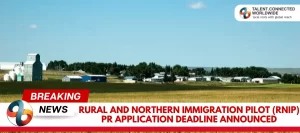
Canada Immigration Trend
Canada’s population is among the oldest in the world, and its birth rate is among the lowest. Financial and economic pressures result from this. Natural population growth is slow in Canada, which hurts employment and economic growth. It is challenging for Canada to raise the taxes necessary to fund social expenditure on services like education, health care, and other crucial areas that ensure the country’s high living standards. Low economic growth makes this difficult.
As a result, Canada has increased immigration levels since the late 1980s to accelerate population growth, labor force expansion, and economic expansion. Canada’s population, labor force, and a growing portion of its economic growth are now mostly driven by immigration. By the year 2030, 9 million baby boomers in Canada will be eligible for retirement at the age of 65. As a result, Canada will have fewer workers and increase social spending on health care. Canada has been proactive in addressing this issue for more than 30 years by steadily increasing its immigration targets.
Since 1988, Canada has consistently accepted more than 200,000 immigrants annually. It has decided in recent years to raise its levels to more than 400,000 annually. The current immigration rate in Canada is about 1.1 percent. In other words, on a per-capita basis, Canada accepts three times more immigrants than the United States of America. Canada will likely continue to progressively boost its immigration numbers over the next few years based on its demographic realities and immigration trends. Immigration will continue to be essential to maintaining the nation’s budgetary stability and thriving economy.
Furthermore, there is a compelling case to be made that the coronavirus pandemic has increased the relevance of immigration. In the short term, COVID-19 has hurt Canada’s economy and raised government spending on social services. Additionally, in 2019 Canada’s birth rate was 1.47 children per woman, a record low. Given the low birth rate before the pandemic and the possibility that the epidemic would further lower the birth rate owing to economic instability, Canada will be even more dependent on immigration in the years to come to support its population growth. If Canada’s birth rate stays low, immigration will account for an even greater portion of future labour force growth. After COVID-19, Canada will need to increase its revenue base through immigration to fund public spending.
Canada Immigration Statistics
Among the many interesting facts and figures provided by citizenship and immigration Canada, the organization responsible for immigration in Canada is that the organization compiles a large amount of statistical data.
The very large number of immigrants who come to Canada every year has given Canada a nickname which is Land of Immigration.
It is widely believed that immigration to the country is beneficial to the country’s cultural and economic health, as well as to its economic well-being.
The Canadian government is proud of its multiculturalism, making it one of the most diverse countries in the world.
In the following sections, you will find some facts about immigration in Canada. These statistics are all derived from citizenship and immigration. Unless, all numbers are for 2012. The 2013 statistics have not been released yet since the year has not yet ended. Unless, all numbers are for
- The Family Residency Program granted Permanent Residency to 65,008 immigrants. People in this group apply for entry into Canada with the sponsorship of a relative who is a Permanent Resident or Citizen.
- The number of immigrants entering Canada on economic-type Permanent Resident Cards reached 160,819 in 2016. Immigrants have a positive effect on the economy, as previously discussed, as previously discussed. A job already in the country sponsored these immigrants’ entry into Canada.
- To protect refugees from persecution in other countries, 23,094 were granted Permanent Residency in Canada.
· The number of Canadians who were granted Permanent Residency in 2012 equaled 257,887. It is interesting to note that this number is higher than the 20-year average.
Canada Immigration Statistics 2022 by Country
The Immigration Levels Plan for Canada has been updated for the first time since October 2020. Every year on November 1st, the Canadian government unveils a new immigration strategy. However, they waited until this year to announce because of the 2021 election. The plan specifies how many immigrants Canada intends to admit over the following three years via its numerous provincial and federal initiatives. The prior target levels for immigration were the highest in Canadian history. The new strategy has upped annual targets for immigration by more than 20,000 additional permanent residents. Targeted economic immigration increased from 241,500 to 241,850 in 2022. But the number of Federal High Skilled employees fell from 110,500 to 55,900. IRCC, however, created space for 72,000.
Canada Immigration Rates by Year
There were reportedly 76,000 FHS candidates in stock, according to an internal memo that was recently made public and dates back to November 2021. In the document, it was suggested that FHS intake be suspended for at least the first half of the year because this is much greater than what was required to satisfy the Federal High Skilled (CEC, FSW, FST) admissions targets for 2022. Since December 2020, IRCC has suspended Federal Skilled Workers (FSW) drawings. They also stopped sending invitations to applicants for the Canadian Experience Class (CEC) starting in September 2021. Recent Express Entry draws in Canada, however, have prioritized accepting candidates from the Provincial Nominee Program (PNP) and have continued to invite immigrants via federal economic programs.
According to the new immigration strategy, Canada will continue to prioritize these applicants for 2022 and will pay less attention to the FSW and CEC categories. This will allow for the large number of newcomers who will be applying through the TR to PR Public Policy when it is put into effect in 2021. Therefore, applicants desiring to immigrate to Canada should first review the nomination programs provided by the province in which they choose to settle. Canada depends on immigration to maintain population growth and fill labor market gaps due to an aging population and declining fertility rates. In a post-pandemic economy, the most recent announcement confirms Canada’s reliance on immigration.
Has Immigration to Canada Increased
After a difficult 2020 caused by the COVID-19 crisis, the 2021–2023 Immigration Levels Plan is introduced. Since March, there have been severe restrictions on international travel, and the U.S. border has been closed. As a result, the number of people applying to become permanent residents has dropped significantly. Despite plans to welcome 341,000 newcomers, Canada will fall far short of that goal given the lack of any indication that restrictions will be relaxed or the border will reopen. In the eight months leading up to August, Canada had admissions of 128.430 permanent residents. It follows Canada’s 2019 admission of more than 341,000 new permanent residents, which set a new high for the contemporary era.
Despite the coronavirus outbreak, Canada’s immigration system has continued to function. The Canadian government has stated that it wants to keep the immigration system as stable as possible so that it may continue to accept skilled workers, family-class immigrants, refugees, temporary foreign workers, international students, and visitors.
Canada initially indicated that some new permanent residents would be permitted to enter the country when COVID-19 travel restrictions were put in place. In 2020, COVID-19 reduced the number of new immigrants arriving in Canada as permanent residents; however, in 2021, new immigration landings surged as IRCC’s processing capacity grew.
Canada continues to extend fresh invitations to immigrate to qualified professionals through its Express Entry, Provincial Nominee Program (PNP), and immigration programmes in Quebec. The processing of spousal sponsorship applications is also underway.
Economic Programs
- Federal Skilled Worker (FSW) Program:
For immigrants with the necessary training, job history, fluency in English or French, and other skills necessary to establish themselves economically in Canada, this Express Entry-managed program is available. - Federal Skilled Trades Class (FSTC):
Foreign employees having training in a skilled trade are eligible for the Express Entry-managed Federal Skilled Trades Class. - Canadian Experience Class (CEC):
Expressions of interest from foreign employees with Canadian work experience or recent graduates of Canadian educational institutions working in Canada are welcome in the Canadian Experience Class, which is administered under the Express Entry system. - Atlantic Immigration Pilot Program (AIPP):
The Atlantic Immigration Pilot program enables some Atlantic firms to find and hire foreign graduates or skilled workers in the Atlantic Canada region (Newfoundland and Labrador, Prince Edward Island, Nova Scotia, and New Brunswick). - Caregivers Program:
Canada offers eligible foreigners the chance to seek permanent residence while providing care for children and individuals with significant medical needs. - Federal Business:
Federal business class programs allow eligible foreigners to manage new or existing enterprises in Canada. - Provincial Nominee Program (PNP):
Through this program, member provinces and territories can suggest individuals for permanent residency in Canada who meet the requirements for economic immigration. - Quebec Business and Quebec Skilled Worker Program:
Outside of the federal system, the province of Quebec manages its immigration program. The levels that the Quebec government intends to implement from 2019 to 2021 are still to be established.
Will Canada Stop Immigration after 2025?
The answer to this question is NO because Canada is the country which is known as the “Land of Immigration” and it will never stop immigration after 2025. It is estimated that 1 million new immigrants will be welcomed by the federal government within three years. It is no secret that Canada has a large immigrant population and that its diversity is one of its greatest assets. As a result of their contributions, newcomers play a vital role in enabling the economy to grow and building strong communities across the country.








